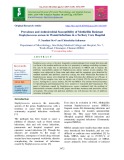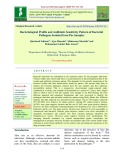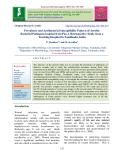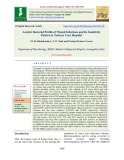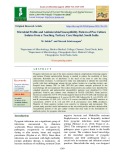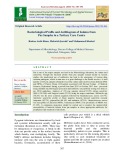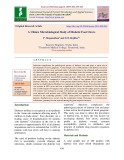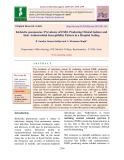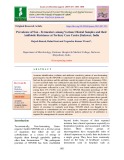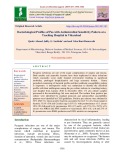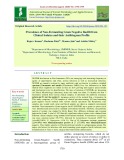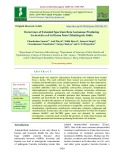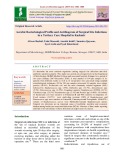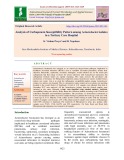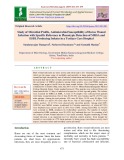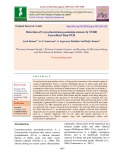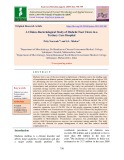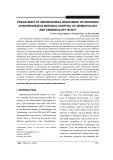
Pus culture
-
The aim of the study was to determine the prevalence of MRSA and to analyze the antibiotic susceptibility pattern of Staphylococcus aureus isolates in pus samples. Pus samples were subjected to Gram stain and culture and the organisms were identified by standard methods and antibiotic sensitivity testing was done.
 8p
8p  cothumenhmong9
cothumenhmong9
 04-01-2021
04-01-2021
 22
22
 1
1
 Download
Download
-
Pus culture, Sensitivity, Resistance, MRSA, ESBL. The aim of the study was to determine the commonly isolated aerobic microorganisms found in pus samples and their antibiotic sensitivity pattern. This study was conducted in the Government Medical College Hospital, Thoothukudi from January to December 2016. Pus samples received from various departments are processed by standard protocols. Antibiotic susceptibility was done by Kirby Bauer disc diffusion method.
 9p
9p  gaocaolon9
gaocaolon9
 22-12-2020
22-12-2020
 22
22
 2
2
 Download
Download
-
This is a prospective, observational, single-centered study, conducted in a tertiary care hospital in Hyderabad for a period of 2 years, from August 2016 to 2018.
 9p
9p  nguaconbaynhay7
nguaconbaynhay7
 15-08-2020
15-08-2020
 8
8
 1
1
 Download
Download
-
The objective of the present study was to ascertain the prevalence of pathogens of infective wounds and to study the antimicrobial resistance among them with commonly used antibiotics retrospectively. A total of 912 pus specimens from patients were received from IPDs and OPDs and tested for aerobic culture and sensitivity in Villupuram Medical College, Tamilnadu, India, were cultured by standard microbiological procedures for the isolation of pathogens.
 6p
6p  nguaconbaynhay6
nguaconbaynhay6
 23-06-2020
23-06-2020
 19
19
 1
1
 Download
Download
-
A wound is a breach in the skin and the exposure of subcutaneous tissue following loss of skin integrity. Wound infection occurs as a complication of surgery, trauma or disease that may interrupt a mucosal or skin surface. Wound infections are one of the most common hospital acquired infections. They are an important cause of morbidity and mortality.
 12p
12p  chauchaungayxua5
chauchaungayxua5
 08-05-2020
08-05-2020
 27
27
 0
0
 Download
Download
-
Pyogenic infections are one of the most common clinical complications following surgery and trauma. Prompt antimicrobial therapy is needed to reduce the morbidity of these infections. Rationale use of antibiotics is the need of the hour to curb the rising antimicrobial resistance. A retrospective study was undertaken to identify the microbial profile with their antibiogram among the pus culture isolates in a teaching tertiary care hospital from January 2017 to June 2017.504 pus culture samples processed at the microbiology lab were analyzed.
 5p
5p  nguathienthan4
nguathienthan4
 18-04-2020
18-04-2020
 16
16
 0
0
 Download
Download
-
us is one of the major samples received in the Microbiology laboratory for culture and sensitivity. Though the bacterial profile from pus samples remain similar in various studies, the inadvertent use of antibiotics has lead to the emergence of various drug resistant pathogens, which in turn acts as a great challenge to the health services.
 8p
8p  trinhthamhodang4
trinhthamhodang4
 22-03-2020
22-03-2020
 17
17
 0
0
 Download
Download
-
Infection complicates the pathological picture of diabetic foot and plays a main role in development of moist gangrene. A total sample size of 100 patients with diabetic foot ulcer was included in this cross sectional study. A detailed history was obtained and assessment of clinical symptoms and signs were made. Discharge from the lesions, pus aspirates from the abscesses and debrided necrotic materials were collected. Aerobic culture anerobic culture and antibiotic susceptibility testing was done. Males were the predominant group in this study 66% as compared to females 34%.
 5p
5p  cothumenhmong3
cothumenhmong3
 22-02-2020
22-02-2020
 24
24
 0
0
 Download
Download
-
The incidence of infections caused by multidrug resistant ESBL producing K.pneumoniae is on rise. The treatment of these infections have become increasingly difficult and life threatening. Knowledge on prevalence of these infections and corresponding antimicrobial susceptibility patterns is essential regionally. Routine standard operative procedures were followed in the laboratory in processing the clinical specimens for culture and sensitivity. ESBL producing K.pneumoniae were identified by phenotypic combination disc test. Majority of K.
 6p
6p  cothumenhmong3
cothumenhmong3
 22-02-2020
22-02-2020
 24
24
 2
2
 Download
Download
-
Accurate identification, isolation and antibiotic sensitivity pattern of non-fermenting gram-negative bacilli (NFGNB) is important for proper patient management. Aim: to find out the prevalence and the antibiotic sensitivity pattern of non- fermenters (NFs). A cross-sectional study was conducted on specimen collected from patients of tertiary care centre and send to microbiology laboratory for culture and sensitivity. Out of 4819 specimens collected in a year, 3363 (69.78%) were found culture positive and among them 378 (7.84%) were positive for NFGNB.
 8p
8p  trinhthamhodang3
trinhthamhodang3
 17-02-2020
17-02-2020
 16
16
 0
0
 Download
Download
-
Pyogenic infections are one of the major complications of surgery and trauma. Both aerobic and anaerobic bacteria have been implicated in these infections which commonly occur under hospital environment resulting in significant morbidity, prolonged hospitalization and huge economic burden. Hence periodical monitoring of bacterial profile and their antibiotic susceptibility pattern is important. A retrospective study was undertaken to identify the microbial profile with their antibiogram among the pus culture isolates in a teaching tertiary care hospital from January 2018 to December 2018.
 9p
9p  trinhthamhodang3
trinhthamhodang3
 14-02-2020
14-02-2020
 15
15
 2
2
 Download
Download
-
NFGNB also known as Non-fermenters (NFs) are emerging with increasing frequency as agents of opportunistic and often, serious infection as well as nosocomial infection. NFGNB are innately resistant to many antibiotics and are known to produce extended spectrum β-lactamases and metallo β-lactamases (MBL).Very few laboratories in India identify these organisms as routine as they are slow growing and requires special media and biochemical tests for identification. The rates of isolation of NFGNBs are increasing in Clinical Microbiology Laboratory, hence this study was done.
 10p
10p  nguaconbaynhay3
nguaconbaynhay3
 07-02-2020
07-02-2020
 24
24
 1
1
 Download
Download
-
Present study was aimed to characterize Escherichia coli isolated from wound from a hyena. Pus swab collected from wound was processed for bacterial isolation and identification as per standard protocol. Isolate was then subjected to antimicrobial susceptibility test by disc diffusion method using commercial available antibiotics such as ampicillin, amoxycillin, amoxyclav, trimethoprim, chloramphenicol, ciprofloxacin, enrofloxacin, cefepime, cefotaxime, ceftriaxone, ceftriaxone/tazobactum, gentamicin and oxytetracycline.
 8p
8p  nguaconbaynhay3
nguaconbaynhay3
 07-02-2020
07-02-2020
 12
12
 0
0
 Download
Download
-
To determine the most common organisms causing surgical site infections and their antibiotic sensitivity pattern. This study was carried out retrospectively in the Department of Microbiology SKIMS Medical College and associated hospital, Srinagar for a period of two years (January 2017–December 2018). A total number of 194 pus samples of inpatients from different wards as well as of out-patients were processed using standard microbiological techniques. Of the 194 pus samples processed, 94 samples were culture positive (48.4%).
 8p
8p  quenchua2
quenchua2
 15-12-2019
15-12-2019
 23
23
 1
1
 Download
Download
-
Acinetobacter baumannii has emerged as an extensively-drug-resistant pathogen implicated in healthcare associated infections (HCAIs) such as ventilator associated pneumonia, urinary tract infection, bacteremia, septicemia, secondary meningitis, wound infection etc. In the recent past carbapenems had been drugs of choice for serious infections with Acinetobacter baumannii, but carbapenem resistant strains are rapidly emerging. This study assesses the prevalence and mechanisms of resistance for Meropenem, Imipenem among Acinetobacter species isolated from a tertiary care center.
 7p
7p  kequaidan2
kequaidan2
 13-12-2019
13-12-2019
 23
23
 0
0
 Download
Download
-
Burn wound infections are most serious and often lead to life- threatening complications which are the major cause of morbidity and mortality in burns patients. Generally burn wound has high susceptibility rate of bacterial colonization and infection, this is because of destroyed skin barrier due to burns and which leads to direct bacterimic spread. To detect the prevalence of MRSA producers among Gram positive cocci and ESBL producers among Gram negative bacilli from the burn wound isolates. This Prospective study was conducted for 3 months (May, June July 2017) at Govt.
 9p
9p  kequaidan2
kequaidan2
 11-12-2019
11-12-2019
 16
16
 1
1
 Download
Download
-
Corynebacterium pseudotuberculosis, a Gram positive bacterium is the causative agent of caseous lymphadenitis (CLA), a chronic debilitating disease of sheep, goats and other warm blooded animals. Definite diagnosis of CLA primarily relies on microbiological examination, followed by biochemical identification of isolates. In an effort to facilitate C. pseudotuberculosis detection, the present study was undertaken with the aim of evaluating a SYBR Green real time PCR assay targeting ABC transporter gene for the detection of C.
 6p
6p  cothumenhmong1
cothumenhmong1
 08-12-2019
08-12-2019
 22
22
 0
0
 Download
Download
-
Diabetic foot is one of the most feared complications of diabetes and is the leading cause of hospitalization in diabetic patients. Diabetic patients have a lifetime risk as high as 25% for developing into foot ulceration. The reasons for the increased incidence of diabetic ulcer involve the interaction of several pathogenic factors like neuropathy, abnormal foot biomechanics and peripheral arterial disease. The study was performed to determine the microbial etiology (aerobic and anaerobic) of diabetic foot ulcer and their susceptibility pattern in a tertiary care hospital.
 10p
10p  cothumenhmong1
cothumenhmong1
 08-12-2019
08-12-2019
 30
30
 0
0
 Download
Download
-
To describe the antimicrobial resistant levels of isolated N. gonorrhoeae. Methods: This was a cross sectional study. N. gonorrhoeae was isolated from pus or discharge of 1582 patients with urethral and/or vaginal discharge syndromes. Isolates were determined by using Gram staining, culture, and identification test, followed by antimicrobial susceptibility method. Minimum inhibitory concentration (MIC) was performed to differentiate the between resistant and susceptible isolates.
 7p
7p  nguyentuananh2502
nguyentuananh2502
 03-04-2019
03-04-2019
 33
33
 2
2
 Download
Download
CHỦ ĐỀ BẠN MUỐN TÌM









